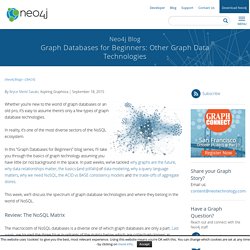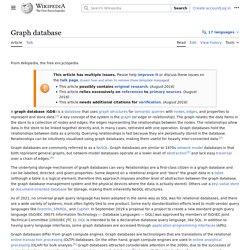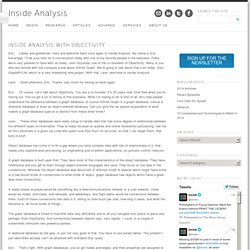

Graph based risk management. SQL vs NoSQL: The Differences. SQL (Structured Query Language) databases have been a primary data storage mechanism for more than four decades.

Usage exploded in the late 1990s with the rise of web applications and open-source options such as MySQL, PostgreSQL and SQLite. NoSQL databases have existed since the 1960s, but have been recently gaining traction with popular options such as MongoDB, CouchDB, Redis and Apache Cassandra. You’ll find many tutorials explaining how to use a particular flavor of SQL or NoSQL, but few discuss why you should choose one in preference to the other. I hope to fill that gap.
In this article, we’ll cover the fundamental differences. Most examples apply to the popular MySQL SQL and MongoDB NoSQL database systems. The SQL vs NoSQL Holy War Before we go further, let’s dispel a number of myths … MYTH: NoSQL supersedes SQL That would be like saying boats were superseded by cars because they’re a newer technology.
MYTH: SQL vs NoSQL is a clear distinction This is not necessarily true. Graph Databases for Beginners: Other Graph Data Technologies. By Bryce Merkl Sasaki, Aspiring Graphista | September 18, 2015 Whether you’re new to the world of graph databases or an old pro, it’s easy to assume there’s only a few types of graph database technologies.

In reality, it’s one of the most diverse sectors of the NoSQL ecosystem. In this “Graph Databases for Beginners” blog series, I’ll take you through the basics of graph technology assuming you have little (or no) background in the space. In past weeks, we’ve tackled why graphs are the future, why data relationships matter, the basics (and pitfalls) of data modeling, why a query language matters, why we need NoSQL, the ACID vs BASE consistency models and the trade-offs of aggregate stores. This week, we’ll discuss the spectrum of graph database technologies and where they belong in the world of NoSQL. Graph Databases for Beginners: Other Graph Data Technologies.
Graphs. Overview Graph databases. Graph databases are part of the NoSQL databases created to address the limitations of the existing relational databases.

While the graph model explicitly lays out the dependencies between nodes of data, the relational model and other NoSQL database models link the data by implicit connections. Graph databases, by design, allow simple and fast retrieval[citation needed] of complex hierarchical structures that are difficult to model[according to whom?] In relational systems. Graph databases are similar to 1970s network model databases in that both represent general graphs, but network-model databases operate at a lower level of abstraction[3] and lack easy traversal over a chain of edges.[4] Graph databases differ from graph compute engines. Background Graph databases, on the other hand, portrays the data as it is viewed conceptually. Graph Graph databases employ nodes, properties, and edges. A graph within graph databases is based on graph theory. Graph models Labeled-property graph History. Graph DB use cases. Eric: Ladies and gentlemen, hello and welcome back once again to Inside Analysis.

My name is Eric Kavanagh. I’ll be your host for a conversation today with one of my favorite people in the business. Folks, we’re very pleased to have with us today, Leon Guzenda, one of the co-founders of Objectivity. Many of you who are familiar with the company know about Infinite Graph. We’re going to talk about that a bit today. Leon: Good afternoon, Eric. Eric: Of course. Leon: These other databases were really setup to handle data that had some degree of relationship between the different types of information. Object database has come in to fill a gap where you have complex data with lots of relationships in it, that needs very sophisticated processing, so engineering and scientific applications, so process control, telecom. A graph database is built upon that. A really simple example would be something like a telecommunications network or a road network. Eric: That’s right. Leon: Exactly.